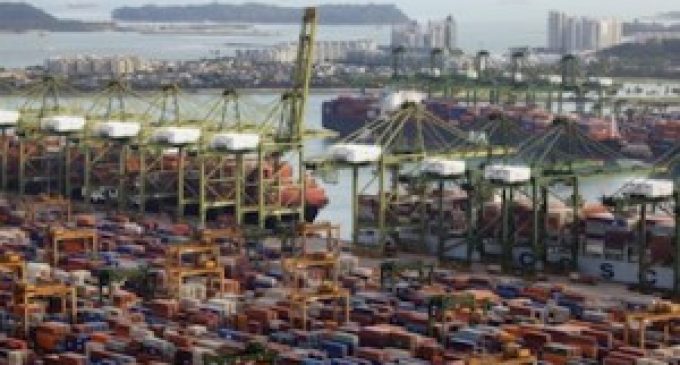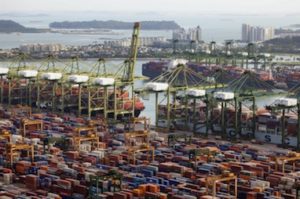2015 FIN – West Coast Port Slowdown May Become Lockout

February 17, 2015 FIN – A lockout or strike is looming at the 29 West Coast ports in the U.S. after months of labor “slowdown” and management shutdowns over the first two weekends of February.
The White House announced that Labor Secretary Tom Perez will meet with both sides to “urge them to resolve their dispute quickly at the bargaining table.”
Bill Giddins, president of Continental-Aero, has numbers to show what is already happening in the fastener industry due to the slow down.
“The average length of time from Asian ports to one of our warehouses – not just total shipping time – was 3 1/2 weeks,” Giddins told FIN. “Now it is running anywhere from six to seven-plus weeks. Certain shipments get shunted to the side and can linger even longer. We have one container outstanding since December 3, 2014.”
Not only are containers slower to arrive, but Peggy Hsieh of Brighton-Best International pointed out that “getting new containers booked in Asia is a challenge due to lack of containers going back in a timely manner.”
“Like everyone else, we are also feeling a port slowdown,” Hsieh told FIN.
Ed Werner of EZ Sockets finds shipments from Taiwan – which normally take four weeks – are now running six to eight-weeks.
“Factories are saying they are shipping,” Werner told FIN. They are promising shipments will “be on the next boat.”
“We are busy,” Werner declared. Customers are still ordering fasteners. Some inventoried items are beginning to run low.
EZ Sockets also is hearing from some buyers who are having trouble finding their fasteners from their regular sources, Werner added.
The West Coast ports handle 70% of imports from Asia. The slowdown has affected domestic rail and trucking.
The Pacific Maritime Association, the multi-employer bargaining association of port terminal operators and shippers, suspended operations for four-day weekends and the International Longshore & Warehouse Union president responded that closing ports was an effort to put economic pressure on union members to settle.
• The U.S. West Coast port labor problems are driving up shipping freight rates as offloading delays make container ships unavailable for new orders. Dozens of container ships are waiting near West Coast ports. The Shanghai Containerized Freight Index rates rose 23 points last week and brokers project higher rates.
• Honda announced it will Japanese slow production at some North America assembly plants due to slow parts delivery and Subaru will continue flying car parts to its U.S. factory despite the higher cost. Toyota has cut some hours. Nissan acknowledge some delays, but emphasized it relies heavily on local suppliers.
• Imports through the Los Angeles-Long Beach port – the largest U.S. container port – dropped about 25% for January 2015 over the same month a year ago.
• Canada’s and Mexico’s Gulf Coast ports are not affected, but the water route from Asia takes longer.
If a strike starts, some are calling for the Obama administration to invoke the Taft-Hartley Act to resolve the situation. The 1947 Taft-Hartley Act allows the president to address labor disputes which threaten free flow of commerce or jeopardize the health and safety of the country.
Federal mediation has been involved since January. Port labor contracts expired in July 2014.
On February 4, the multi-employer bargaining association of port terminal operators and shippers, PMA, offered its “best and final offer” to the union.
PMA threatened a lockout of dockworkers by February 16 if negotiations don’t reach a new contract for the 20,000 dockworkers.
“We think a strike may be the only way for this situation to come to a head as the current situation is not sustainable,” Giddins commented.
But with the U.S. economy being “very robust” and “certain segments gaining momentum, a long-term strike would have a devastating effect and change the current business paradigm,” Giddins suggested.
“The ripple effect is already being felt as the ports are charging increased fees and air cargo space is being taken at unprecedented levels and is at a premium,” Giddins finds.
“A strike would not initially present a problem, but depends on how long a strike would last,” Tom Bigott, purchasing manager for XL Screw Corporation, told FIN.
Industry has been feeling the slowdown, which “has been steadily growing since July.” XL Screw is currently experiencing a two-to-three week delay on containers arriving at warehouses.
The slowdown began last summer, according to Beacon Fasteners national sales manager Kameron Dorsey.
“This has been an ongoing situation since the summer, but has increasingly gotten worse.”
“Different companies have employed different procurement strategies – increasing buys, rerouting to alternate ports, etc. – in anticipation, but combined with the plating situation in Taiwan plus the U.S. demand it is hard to keep inventories at proper levels.”
Plating costs jumped 37% in January, Giddins reported.
Continental-Aero increased its planned inventory levels starting in October in anticipation of problems, Giddins said.
“This has helped to overcome the later delivery, however, spot shortages have become evident.”
Brighton-Best is already see the “slowdown affect fastener supply especially with those wholesalers who live on minimal inventory,” Hsieh observed.
“Due to our large on-hand inventory position, we have had few issues supplying our customers.”
BBI has “not seen our customers need to increase inventory significantly” as the master distributor still has most of what customers need.
“The lesson for the fastener industry is to buy fasteners manufactured in the United States,” suggested Steve Wilson, of Connecticut-based Crescent Manufacturing Inc.
Florida-based Bay State Cable Ties vice president of sales Tim Bagley was emailing potential customers: “Don’t let the port delays hurt your business. Order our American-made products and get them right away.”
A fifth of the members of Congress recently sent a letter to McKenna and ILWU president Robert McEllrath calling for “swift resolution to ongoing West Coast port contract negotiations.” The congressmen emphasized that trade supports 38 million U.S. jobs.
Congestion at ports also hurts U.S. manufacturing, National Association of Manufacturers CEO Jay Timmons said in a speech at Purdue University. Limits on overtime have cost the U.S. “millions of lost wages.”
In 1971 President Richard Nixon invoked Taft-Hartley to end a dock strike. In 2002, President George W. Bush set in motion efforts to end the Wet Coast port shutdown via Taft-Hartley and he threatened military intervention to end a lockout.
The 10-day lockout in 2002 cost the U.S. economy an estimated $1 billion per day. The National Association of Manufacturers projects the cost in 2015 would be $2 billion daily. ©2015 Fastener Industry News.
2015 FIN – U.S. West Coast Ports ‘Slowly Improving’
April 27, 2015 FIN – Fastener importers report U.S. West Coast ports are receiving and moving goods, but are not yet fully recovered from the nine-month slowdown which ended in late February 2015.
Brighton-Best International received more than 100 containers during the second week of April when they normally would process 40, Hsieh reported. “One hundred is not easy,” Peggy Hsieh said of the workload.
“It is still not normal,” Hsieh observed. She predicted it would be the end of summer before the ports are fully back on schedule.
Shipping companies and the 20,000 dockworkers for the 29 U.S. West Coast ports reached a tentative labor deal late February 21, 2015, after negotiations since the dockworker contract expired in July 2014. The International Longshore & Warehouse Union and the shippers’ bargaining agent, the Pacific Maritime Association, agreed to “fully restore all port operations” after U.S. labor secretary Thomas Perez arrived in San Francisco to broker a compromise.
Brighton-Best president Jun Xu told FIN that ports in Texas, Georgia and New Jersey helped pick up a portion of the slack.
Xu noted the port slowdown affected the “entire U.S. economy. Everyone got delays.”
“Slowly improving,” Chuck Smith of AZ Lifting Hardware declared of the current situation during a Pacific-West Fastener Association conference session last week.
Craig Harper of WCL Company found the biggest problem during the slowdown to be the “uncertainty.” Inventory was sitting on ships with no schedule to get to the docks. “We had no idea whether it would be one week or three weeks,” Harper said during the Pac-West session.
Some distributors were approached by competitors’ customers needing fasteners, Dallas Puckett of Valley Nut & Bolt said. “You had to make a quick decision whether to make an extra buck” on the quick sale “vs. going with the long-run customer,” Puckett said.
Suzanne Dukes of Hayes Bolt found the port slowdown to be an opportunity to communicate with customers. “Hopefully customers don’t often have need to talk to us,” Dukes said. “This was an opportunity to go in to the customer and act as consultant on sourcing.”
The bottom line is that the port slowdown never got bad enough to create “an emergency situation,” Hsieh summarized. ©2015 Fastener Industry News.



There are no comments at the moment, do you want to add one?
Write a comment